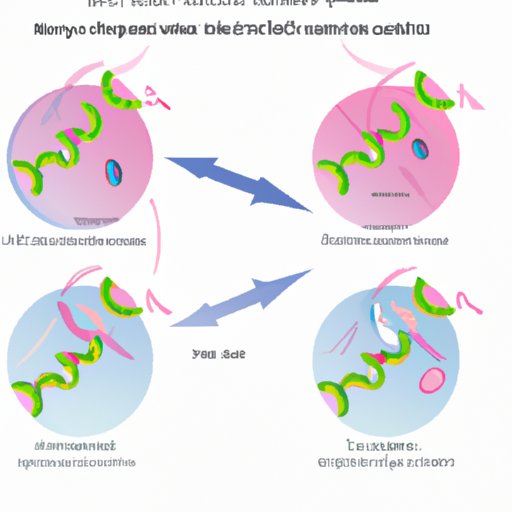Introduction
Have you ever wondered when DNA gets copied in your cells? DNA replication is a crucial process that occurs during the cell cycle, ensuring that cells have the proper genetic information to function correctly. In this article, we explore the stages of the cell cycle and the mechanisms of DNA replication, including how it is regulated and the consequences of errors in DNA replication.
The Cell Cycle: Understanding DNA Replication
The cell cycle is the process by which cells divide and replicate. It is divided into different phases, including G1 (gap 1), S (synthesis), G2 (gap 2), and M (mitosis). During the G1 phase, cells grow and prepare for DNA replication. In the S phase, DNA replication occurs, and cells duplicate their genetic material. G2 phase follows, where the cell checks if the duplication is complete and prepares for mitosis, the final stage where cells divide and separate their duplicated DNA.
DNA replication is vital to the cell cycle as it ensures that daughter cells have the same genetic information. Proper DNA replication is essential for normal cell growth and the prevention of genetic abnormalities or diseases such as cancer.
The Process of DNA Replication during the S-phase of the Cell Cycle
The S phase is when DNA replication occurs. The process goes through three phases: initiation, elongation, and termination.
Initiation involves the separation of the two strands of the DNA helix, allowing the replication machinery to access the genetic information. This separation is facilitated by enzymes that unwind and separate the DNA strands.
Elongation is the process of copying the DNA strands. Enzymes attach nucleotides to each of the single strands, following the base-pairing rules of adenine (A) with thymine (T) and cytosine (C) with guanine (G). These nucleotides are then linked together with covalent bonds to create two new double-stranded DNA molecules.
Termination is the final stage of DNA replication, where the two DNA helices are separated from each other by other enzymes. Once the DNA strands are separated, each daughter cell receives a copy of the original DNA strand.
Enzymes and proteins play a vital role in the DNA replication process. DNA polymerase adds nucleotides to the newly replicated strand and proofreads the newly synthesized DNA chains for errors. Helicase separates the DNA double strand, allowing the replication machinery to access the genetic information. Ligase connects the separate segments of the newly synthesized DNA strands. Errors in the DNA replication process can lead to genetic abnormalities or diseases such as cancer.
The Mechanisms and Regulation of DNA Synthesis during Cell Division
Many mechanisms regulate DNA synthesis during cell division, ensuring that the DNA is copied correctly. Checkpoints monitor the DNA during the cell cycle and ensure that the cell replicates its genetic material correctly. The checkpoints act as signals that slow down or stop the cell cycle to prevent errors from being passed on to the next generation of cells.
Mutations in DNA replication can lead to cancer and other genetic abnormalities. Mutations can result from external factors such as radiation exposure or chemical exposure or internal factors such as errors in the replication machinery itself.
Understanding the Importance of DNA Replication during Mitosis
DNA replication during mitosis ensures that each daughter cell receives the correct set of genetic information. Errors during the replication process can result in daughter cells with abnormal chromosome numbers and structures. Such abnormalities can result in diseases such as cancer and genetic disorders.
The consequences of DNA replication errors during mitosis can be severe. For example, errors in chromosome copying can cause chromosomal abnormalities, resulting in genetic disorders such as Down Syndrome. Cancer can result from mutations in the DNA that cause uncontrolled cell growth or interfere with the checkpoints that prevent the cell from dividing uncontrollably.
Exploring the Stages of DNA Replication in the Cell Cycle: From G1 to G2
DNA replication occurs at different stages of the cell cycle. During the G1 phase, the cell prepares to replicate its genetic material. The S phase follows, where DNA replication occurs, and the cell duplicates its genetic information. During the G2 phase, the cell checks if the replication is complete and prepares for mitosis. The final stage is mitosis, where daughter cells divide and receive a copy of the replicated DNA.
The regulation of DNA replication is different in normal and cancerous cells. Normal cells have checkpoints to ensure that the DNA replication process is tightly regulated and accurate. On the other hand, cells with cancer often have mutations that alter the checkpoints, resulting in uncontrolled cell growth and the spread of cancerous cells.
Conclusion
DNA replication is a vital process that occurs during the cell cycle, ensuring that daughter cells have the correct set of genetic information. Understanding the different stages of the cell cycle and the mechanisms of DNA replication can help us understand the consequences of replication errors such as genetic abnormalities and diseases. It is essential to prevent errors during DNA replication to maintain proper cell growth and prevent genetic disorders. Seeking professional help if you are concerned about DNA replication in your cells can help detect and prevent such errors.
Tips for Preventing Errors in DNA Replication
- Avoid exposure to chemicals, radiation, and other mutagens that may increase the chances of DNA replication errors.
- Eat a healthy diet, exercise regularly and practice other healthy habits to reduce the risk of genetic abnormalities and diseases.
- Consult a professional healthcare provider if you have concerns about genetic abnormalities or diseases related to DNA replication.
